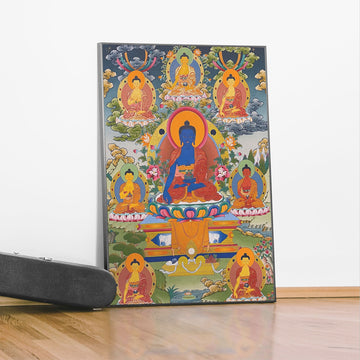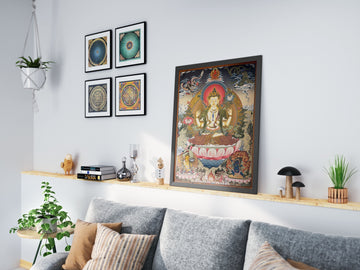Thangka paintings are more than just visual masterpieces—they are sacred vessels of Tibetan spirituality and culture. But how is a Thangka created? Behind each piece lies a meticulous, spiritually rich process involving sacred geometry, hand-ground pigments, and months of devotion. In this article, we guide you through each step in the journey of creating an authentic Thangka painting.
1. Preparing the Canvas: A Spiritual Foundation
The journey begins with a plain piece of cotton or silk. The canvas is carefully stretched over a wooden frame and primed with a traditional mixture of chalk and glue, then polished to a smooth, durable surface. This foundational work ensures the paint will adhere—and that the artwork will last for generations.
2. Drawing the Sacred Geometry
Thangka painting is rooted in divine proportion. Artists use precise grids based on sacred geometry to sketch out the subject—be it the Buddha, Tara, or wrathful deities. Every line, angle, and placement follows strict spiritual symbolism.
Tip: This stage requires deep concentration. Many artists meditate before they begin, ensuring a peaceful mind influences the sacred art.
3. Applying Natural Mineral Pigments
Color in a Thangka isn’t just for beauty—it holds spiritual meaning. Traditional Thangka painters grind minerals like lapis lazuli, malachite, cinnabar, and gold into pigments. These are mixed with animal glue or plant gum and carefully layered onto the canvas.
Common Symbolic Colors:
- Blue – Wisdom & sky
- Red – Power & passion
- Green – Balance & action
- Gold – Enlightenment & purity
4. Detailing and Gilding the Figures
After the base colors are filled in, artists begin fine detailing—painting robes, jewelry, mandalas, and symbolic objects. Real gold or gold leaf is often used to highlight sacred areas like halos, ornaments, or scriptural elements.
The artist may spend weeks—sometimes months—perfecting every detail.
5. Consecration: The Final, Sacred Step
A Thangka is not complete until it’s consecrated by a Lama or monk. Mantras are chanted, incense is burned, and the painting is spiritually blessed. This awakens the Thangka’s energy, transforming it from art into a living spiritual tool.
6. Mounting the Thangka
Finally, the Thangka is sewn into a silk brocade frame with wooden rods, allowing it to be rolled or hung. This traditional mounting style reflects the Thangka’s origins as a portable altar for monks and pilgrims.
Final Thoughts
Understanding the step-by-step creation of a Thangka painting adds depth to its beauty. At Crafts of Tibet, each Thangka we offer is handmade by master artisans in Nepal and Tibet—preserving centuries of sacred tradition.
Explore our authentic hand-painted Thangka collection here.




